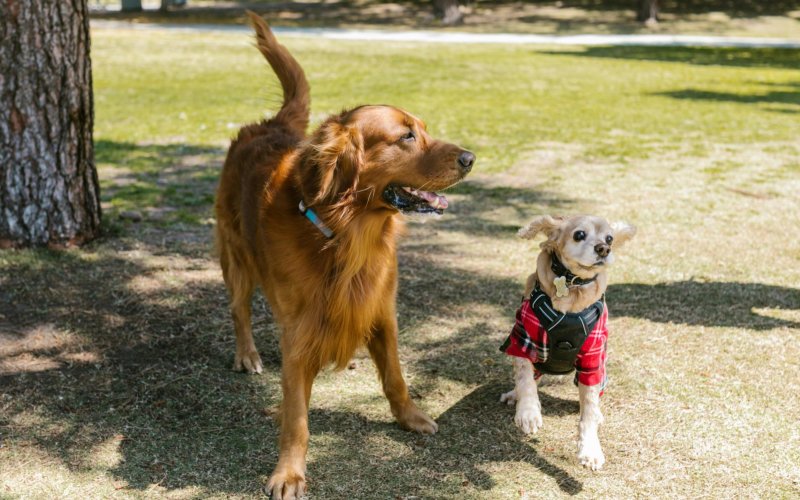If you’re looking to train your dog to stop barking, you’re not alone. Excessive barking can be a common challenge for dog owners, but understanding why your dog barks and how to manage this behaviour is crucial for creating a peaceful home environment. In this guide, we’ll explore effective techniques and strategies to help you reduce your dog’s barking, ensuring both you and your pet can enjoy a harmonious relationship.
Table of Contents
Understanding Why Dogs Bark
One of the first steps to train your dog to stop barking is to understand why dogs bark in the first place. Barking is a natural behaviour for dogs, used as a form of communication. However, certain triggers can lead to excessive barking, which can become a challenge for owners. By identifying the specific reasons behind your dog’s barking, you can address it more effectively and start using the right training techniques to encourage quieter behaviour.
Dogs often bark for one or more of the following reasons:
- Alert Barking: Dogs may bark to alert you to something unusual or unfamiliar in their environment, such as a passing car or someone at the door. This type of barking is often instinctive and linked to their protective instincts.
- Attention-Seeking: Many dogs bark simply because they want your attention. Whether they’re asking for play, food, or a bit of company, attention-seeking barking is a common issue. This can often be resolved by teaching your dog that they’ll get attention when they’re quiet rather than noisy.
- Boredom or Loneliness: Dogs are social animals, and when left alone or bored, they may bark out of frustration. Providing mental and physical stimulation is essential to prevent this type of barking and keep your dog entertained.
- Anxiety or Fear: Dogs may bark when they’re feeling anxious or frightened. This can include separation anxiety when they’re left alone, or fear of certain sounds, people, or other animals. Addressing the root of the anxiety is essential in reducing this barking.
- Excitement: Barking from excitement often occurs when dogs are about to go on a walk, see another dog, or engage in playtime. This type of barking is usually light-hearted but can become disruptive if not managed.
- Territorial or Protective Instincts: Some dogs bark to protect their space or family. If they feel their home is being threatened, they may bark persistently to deter intruders, whether that’s another dog, a delivery person, or a passerby.
Understanding these different motivations is the first step in addressing barking. Once you know the cause, you can take targeted steps to train your dog to stop barking in a positive, constructive way. By using training methods that address the underlying cause of your dog’s barking, you’ll be able to help them understand when it’s okay to bark and when it’s time to stay quiet.

When Barking is Normal vs. Problematic
One important step as you train your dog to stop barking is understanding the difference between normal barking and problematic barking. Barking is a natural behaviour and an essential way for dogs to communicate, but sometimes it can become excessive, leading to stress for both dogs and owners. Recognising when barking is normal and when it may require attention is key to effective training.
Normal Barking: Normal barking is generally short-lived and occurs in response to specific events. For example, it’s common for a dog to bark briefly when someone knocks on the door, during playtime, or if they see another dog on a walk. This kind of barking serves as an alert or an expression of excitement. In these cases, barking is typically easy to control with basic training and doesn’t disrupt daily life.
Problematic Barking: Barking can become problematic when it’s excessive, prolonged, or triggered by minor or constant events. Dogs who bark repeatedly at every sound, passer-by, or change in their environment may be struggling with underlying issues such as boredom, anxiety, or a lack of mental stimulation. Problematic barking may also occur if a dog is left alone for long periods without enough exercise or interaction.
To successfully train your dog to stop barking, start by identifying which type of barking they’re displaying and consider the potential triggers. Addressing the cause, whether it’s a need for more stimulation or a source of anxiety, will make your training efforts far more effective. Once you understand the difference between normal and problematic barking, you can use training methods that suit your dog’s needs, creating a happier and quieter environment for both of you.
The Role of Consistent Commands and Cues
To effectively train your dog to stop barking, consistency in commands and cues is essential. Dogs respond best when they have clear guidance, so using the same command each time they bark excessively will help them understand what’s expected. Consistency not only strengthens the training but also prevents confusion, making it easier for your dog to learn and follow your lead.
Choose a specific command like “quiet” or “enough” and use it consistently each time you want your dog to stop barking. When your dog begins barking, calmly say the command in a firm yet gentle tone. As soon as they stop barking, reward them with a treat or praise to reinforce the behaviour. This helps them associate being quiet with positive outcomes, making it more likely they’ll respond to the command in the future.
It’s also important that everyone in the household uses the same command and tone. If one person says “quiet” and another says “stop,” the inconsistency can confuse your dog and slow their progress. By using a single, consistent cue, you’ll speed up the learning process and make the command more effective.
Patience and repetition are key as you train your dog to stop barking. Over time, your dog will start to understand the command and respond to it naturally. With a consistent approach and positive reinforcement, you can help your dog learn when it’s time to be quiet, leading to a calmer, quieter home environment.

Positive Reinforcement Techniques
When working to train your dog to stop barking, positive reinforcement is one of the most effective methods available. Rather than focusing on punishment, positive reinforcement rewards your dog for desirable behaviour, encouraging them to repeat it. This approach not only helps your dog learn to stay quiet on command but also strengthens the bond between you and your pet by fostering trust and understanding.
To use positive reinforcement, start by identifying a reward that motivates your dog. This could be a favourite treat, a toy, or simple praise. When your dog starts barking, calmly give the “quiet” or “enough” command. As soon as your dog stops barking, even if only for a moment, immediately reward them with praise or a treat. The quick reward reinforces the idea that quiet behaviour brings something pleasant.
Consistency is key in this process. Each time your dog stops barking on command, reward them right away. Over time, they’ll begin to associate being quiet with receiving positive attention or treats. This makes it more likely they’ll respond to the command in the future, even without a treat.
Avoid rewarding your dog while they’re barking, as this could unintentionally encourage the barking. The timing of the reward is crucial to ensure that they understand exactly what behaviour you’re rewarding. If they remain quiet for longer periods, increase the amount of praise or offer an extra treat to further reinforce the quiet behaviour.
With patience, consistency, and positive reinforcement, you can successfully train your dog to stop barking in a way that’s enjoyable and encouraging for them, ultimately leading to a more peaceful home environment.
Using Redirect and Distraction Techniques
When it comes to training your dog to stop barking, using redirect and distraction techniques can be highly effective. These methods help to shift your dog’s focus from the trigger causing them to bark to a more appropriate activity or behaviour. By doing so, you not only reduce the barking but also provide your dog with a constructive outlet for their energy and attention.
Redirecting Attention: One effective way to redirect your dog’s attention is to engage them in a different activity. For instance, if your dog barks at the postman, try redirecting their focus to a favourite toy or a game of fetch when you see the postman approaching. By offering a more stimulating and enjoyable alternative, you can prevent your dog from fixating on the trigger that causes them to bark.
Using Distractions: Distraction techniques can also be useful, especially during training sessions. Carry a small supply of treats or a toy to capture your dog’s attention when they begin to bark. For example, if your dog starts barking at a noise outside, you can quickly show them a treat or engage them in a short training exercise, like a sit or down command. This not only distracts them from the barking trigger but also reinforces good behaviour with positive rewards.
Creating a Calm Environment: Additionally, creating a calm environment can help reduce the need for barking. If your dog is easily startled by noises outside, consider using white noise machines or calming music to drown out the distractions. This can lessen the urge to bark and provide a more peaceful atmosphere.
Remember that the goal is to create a positive association with being quiet. By using redirect and distraction techniques, you can train your dog to stop barking while simultaneously enriching their daily routine and reinforcing desirable behaviours.

Desensitising Your Dog to Triggers
An essential strategy to train your dog to stop barking involves desensitising them to the specific triggers that cause them to bark. Desensitisation is the process of gradually exposing your dog to the sounds, sights, or situations that prompt their barking in a controlled manner. This approach can help reduce their reactivity over time, making them more comfortable and less likely to bark excessively.
Identifying Triggers: The first step in desensitisation is identifying what specifically causes your dog to bark. Common triggers include loud noises, other animals, people walking by, or even certain objects. Once you know what makes your dog bark, you can begin the desensitisation process.
Gradual Exposure: Start by exposing your dog to the trigger at a distance or at a low intensity. For example, if your dog barks at other dogs, find a location where they can see another dog from a distance where they are less likely to react. Allow your dog to observe the trigger without feeling overwhelmed. Gradually decrease the distance over several training sessions, always ensuring that your dog remains calm.
Rewarding Calm Behaviour: While your dog is exposed to the trigger, reward them with treats or praise for remaining calm and quiet. This positive reinforcement helps them associate the trigger with good experiences rather than stress or excitement. If your dog starts to bark, calmly remove them from the situation and try again later.
Practice Patience: Desensitisation takes time, and every dog progresses at their own pace. Be patient and consistent in your training. Over time, your dog will become more accustomed to their triggers, and you will find it easier to train your dog to stop barking in response to them.
By using desensitisation techniques, you can help your dog feel more secure and relaxed, ultimately leading to a quieter home environment.
Common Mistakes to Avoid in Bark Training
When you set out to train your dog to stop barking, it’s important to be aware of common mistakes that can hinder your progress. Avoiding these pitfalls will help you create a more effective training plan and lead to better results.
1. Inconsistency in Commands: One of the most significant mistakes is failing to use consistent commands. If you use different words or tones when asking your dog to be quiet, it can confuse them. Choose a specific command, like “quiet,” and stick to it. Ensure that everyone in the household uses the same command to reinforce learning.
2. Punishing Barking Instead of Rewarding Quiet: Many owners mistakenly think that punishing their dog for barking will solve the problem. However, punishment can lead to fear or anxiety and may worsen the barking behaviour. Instead, focus on rewarding your dog for being quiet, which promotes positive behaviour and strengthens your bond.
3. Neglecting to Identify Triggers: Failing to identify what triggers your dog’s barking can make training ineffective. Take the time to observe your dog and pinpoint the specific situations or stimuli that cause them to bark. Once you know their triggers, you can work on desensitising them and using appropriate training techniques.
4. Lack of Patience: Training takes time, and it’s important to be patient. Many owners expect quick results and become frustrated when progress is slow. Remember that every dog learns at their own pace. Consistent practice and positive reinforcement will eventually lead to success.
5. Not Providing Enough Mental and Physical Stimulation: A common mistake is not giving dogs enough exercise and mental engagement. Boredom can lead to excessive barking, as dogs seek attention or stimulation. Incorporate regular exercise, playtime, and puzzle toys into your dog’s routine to keep them satisfied and less likely to bark.
6. Ignoring the Importance of Socialisation: Some owners overlook the role of socialisation in barking behaviour. Failing to expose your dog to various environments, people, and other animals can increase anxiety and barking. Ensure your dog has plenty of opportunities to socialise in a controlled manner, which can help reduce barking over time.
By avoiding these common mistakes, you can create a more effective strategy to train your dog to stop barking, leading to a happier and quieter home for both you and your furry friend.

When to Seek Professional Help
While many barking issues can be addressed with patience and consistency, there are times when seeking professional help may be necessary to train your dog to stop barking. Recognising these situations early can prevent further behavioural issues and lead to a happier home environment.
1. Persistent Barking Despite Training Efforts: If you have been consistently training your dog and implementing various techniques but still struggle with excessive barking, it may be time to consult a professional dog trainer or behaviourist. They can assess your dog’s behaviour and provide personalised strategies tailored to your specific situation.
2. Aggressive Barking: If your dog’s barking escalates into aggressive behaviour, it’s crucial to seek professional guidance immediately. Aggressive barking can indicate fear or anxiety and can pose a risk to other animals and people. A qualified behaviourist can help address the underlying issues contributing to this behaviour and guide you on how to manage it safely.
3. Barking Linked to Anxiety or Fear: If your dog barks excessively during certain situations, such as thunderstorms or fireworks, they may be experiencing anxiety or fear. In these cases, a professional can help you develop a desensitisation plan and provide techniques to help your dog cope with their fears.
4. Changes in Behaviour: If you notice a sudden change in your dog’s barking behaviour, it could signal an underlying health issue or stress. Consult a veterinarian to rule out any medical problems that might be causing discomfort or pain, which can lead to increased barking.
5. Multiple Behavioural Issues: If your dog exhibits other behavioural problems alongside excessive barking, such as destructive chewing or separation anxiety, seeking professional help is advisable. A trainer or behaviourist can address the full scope of behavioural issues, ensuring a comprehensive approach to your dog’s training.
6. Feeling Overwhelmed: If you feel overwhelmed by your dog’s barking and unsure how to proceed, don’t hesitate to reach out for help. Professional trainers and behaviourists have the expertise and experience to guide you through the training process and provide the support you need.
Seeking professional help when necessary can lead to a more effective approach in training your dog to stop barking, ensuring both you and your pet enjoy a peaceful and harmonious living environment.
Conclusion and Final Thoughts
Training your dog to stop barking can be a rewarding journey that enhances the relationship between you and your furry companion. By understanding the reasons behind barking, identifying triggers, and employing techniques such as positive reinforcement, redirection, and desensitisation, you can effectively manage and reduce excessive barking.
Remember to avoid common mistakes, be patient with your dog’s learning process, and ensure they receive ample mental and physical stimulation. If you encounter challenges that seem insurmountable, seeking professional help can provide the guidance and support you need to overcome these obstacles.
With consistent effort and the right approach, you can create a calmer environment in your home while helping your dog feel secure and understood. By following these strategies, you’ll be well on your way to successfully training your dog to stop barking and fostering a harmonious household.




